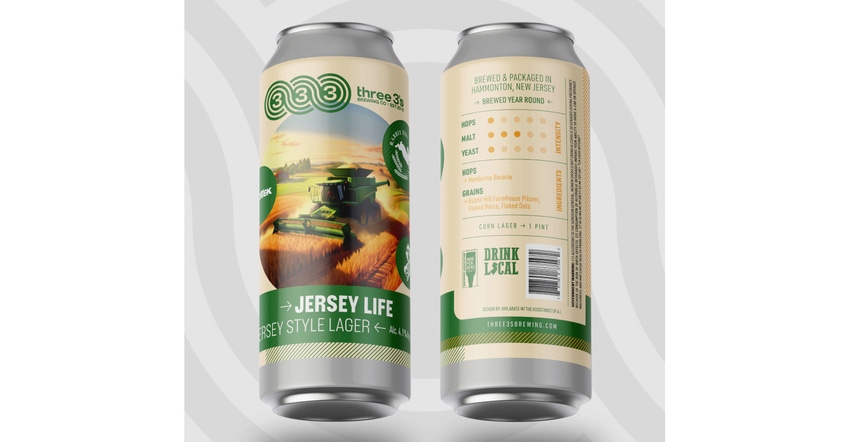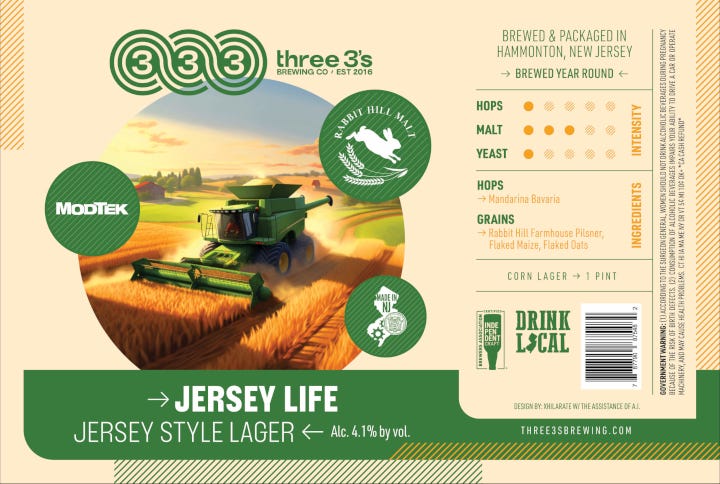How to Use, and Not Use, AI for Package Design
Leverage the benefits while sidestepping the dangers of inviting an artificial intelligence to join your packaging design staff. Here’s how.

Many brands and services are beginning to embrace the use of artificial intelligence (AI) — for creative expression (Midjourney) and copywriting (ChatGPT) — to enhance the customer experience and accelerate the creative research process.
The Xhilarate team found the use of Midjourney to be the best solution for the rebrand of the Three 3’s Craft Beer brand. Midjourney’s ability to create imagery that met the brand’s creative brief and desire to stand out in the marketplace has forced us to think differently about the creative process.
Over time, Three 3’s has released more than 200 beers with names that are inspired by pop culture. Noteworthy names like Back To Reality, Bender Blender, Solstice, White Noiz, and P.B. & Cookies boast captivating hero images that excite and intrigue customers and have come to “define” the brand. Crafting numerous beer label designs that align with the beer names and stay within the brand’s newly defined look and feel required a disciplined process.
In addition to the Three 3’s brand name, the goal was to have consumers recognize the brand through its illustration style developed with the assistance of Midjourney’s AI tool. To do this, it was extremely important for the design team to document all prompts used to create the initial images in order to ensure that a consistent style is maintained across the full range of existing stock-keeping units (SKU’s), new product launches and for on- and off-premise marketing materials. Ultimately, this defined style became a recognizable “dress code” for the Three 3’s brand and provided time and cost efficiencies.
The Three 3’s brand recently launched a new beer, Jersey Life, in partnership with Rabbit Hill Malt and ModTek, a label supplier. The original creative direction guided us to explore a range of themes that said “New Jersey” loud and proud.
Our initial explorations included all things Jersey — the Atlantic City Boardwalk, diners, lighthouses, horse racing, nightlife scenes, and agriculture. The final design focuses on agriculture to reinforce Three 3’s collaboration with Rabbit Hill Malt and to pay homage to New Jersey’s well-known slogan: The Garden State.

Xhilarate
AI can collaborate seamlessly, expanding design horizons and empowering us to craft visually captivating, user-centric experiences that push the boundaries of imagination and deliver exceptional results. It can also be used for inspiration — as a bridge connecting imagination with innovation — as a trusty co-creator and digital companion that emboldens creative spirit and unlocks creative expression.
In another example, when Nutella wanted to stand out in terms of packaging and make its products more desirable and brand more conversational, it used AI and dozens of patterns to create seven million one-of-a-kind labels matching the uniqueness and expressiveness of Italian people. And that’s how Nutella Unica was born.
Potential pitfalls to avoid.
AI is not a substitute for human imagination. Authenticity, emotional resonance, and a brand’s unique essence should always take precedence, ensuring that AI design tools serve as enablers rather than dictators of the brand’s creative direction.
While AI can assist and enhance human imagination by providing tools, insights, and data analysis, it cannot replicate the holistic nature of human imaginative thinking.
While AI can assist and enhance human imagination by providing tools, insights, and data analysis, it cannot replicate the holistic nature of human imaginative thinking. The interplay between creativity, emotions, intuition, and contextual understanding makes human imagination a unique and irreplaceable aspect of human cognition.
The argument for design usage guidelines.
Design usage guidelines are an important aspect of Generative AI implementation from an ethics/risk standpoint. But also from a literal design standpoint, as imagery needs to adhere to specific aesthetics defined by brand identity.
Here are six reasons why design usage guidelines are essential when using Generative AI from both design creation and trademark/ethical usage standpoints:
1. Ensure Consistency: Generative AI can produce a range of outputs and, without stringent guidelines, the generated designs may lack consistency. Guidelines help maintain a coherent visual language and ensure that the output aligns with the overall design aesthetics and established brand identity.
2. Maintain Brand Identity: For businesses and organizations, maintaining a consistent brand identity is crucial for recognition and building trust with customers. Design usage guidelines ensure that the AI-generated designs adhere to the brand’s specific color schemes, typography, logo placement, and other visual elements.
3. Check Possible Ethical Missteps: Generative AI can sometimes produce biased or inappropriate content. Design usage guidelines help establish ethical boundaries and prevent the generation of content that might be offensive, discriminatory, or harmful.
4. Be Time Efficient: Guidelines streamline the design process, saving time and effort for designers and creators. Instead of starting from scratch with each AI-generated design, they can use the guidelines as a starting point and make necessary adjustments to meet the specific requirements of each project.
5. Avoid Overfitting: Generative AI models can sometimes produce outputs that are too specific to the training data, leading to overfitting. Guidelines help prevent this by setting general design principles that allow for flexibility and creativity while avoiding over-reliance on the training data.
6. Adapt to New Inputs: As Generative AI technology evolves, guidelines should be updated to accommodate new features, techniques, and improvements. This ensures that the generated designs remain relevant and up to date.
Design usage guidelines also help with the trademark and ethical considerations that must be taken into account to avoid legal issues and ensure responsible use of the technology.
Trademark considerations include:
• Avoiding Brand Infringement: Generative AI can potentially create designs or content that inadvertently infringes upon existing trademarks. It is essential to ensure that the generated designs do not resemble or imitate established trademarks owned by others.
• Protecting Your Own Trademarks: If you are using generative AI to create designs for your own brand, it is crucial to verify that the AI-generated content does not violate your existing trademarks. The generated content should align with your brand identity and not create confusion among customers.
• Checking Domain Names and Social Media Handles: When using generative AI to generate names or identifiers, it's important to check if they infringe upon existing domain names or social media handles held by other businesses.
Weigh the benefits against the risks.
It's important to consider the potential challenges and ethical concerns associated with AI in packaging. These may include data privacy issues, job displacement, and the irresponsible use of AI technologies.
However, risks aside, using AI for packaging design and development can revolutionize the packaging industry in the following ways:
1. Efficiency and Cost Reduction: AI-powered automation streamlines packaging processes, reducing labor costs and human errors.
2. Customization: AI allows for personalized and on-demand packaging solutions, catering to individual customer preferences and reducing waste from over-production.
3. Quality Control: AI-driven quality control systems can identify defects and ensure that every package meets the highest standards, improving product quality and customer satisfaction.
4. Sustainability: AI can optimize packaging design to minimize waste and use eco-friendly materials, reducing the environmental impact of packaging.
5. Supply Chain Optimization: AI can help optimize the entire supply chain, from inventory management to route planning, ensuring timely and efficient delivery of products.
6. Data Insights: AI generates valuable data about consumer preferences and behaviors, helping businesses make informed decisions and enhance marketing strategies.
7. Safety and Security: AI can enhance package tracking and security measures, reducing the risk of theft or damage during transportation.
8. Brand Image: Innovative packaging solutions driven by AI can set a brand apart, creating a positive image and attracting customers.
To fully harness the benefits, businesses must carefully plan and implement AI solutions while also addressing ethical and societal considerations. AI in packaging is not just a technological advancement; it's a pathway to a more sustainable and customer-centric future.
About the Author(s)
You May Also Like


